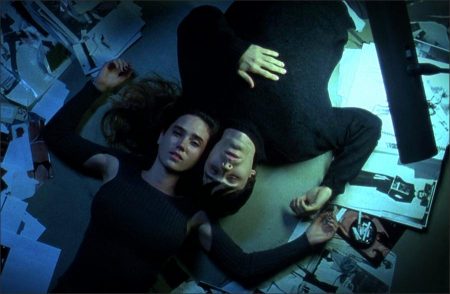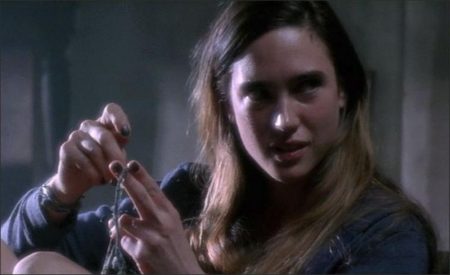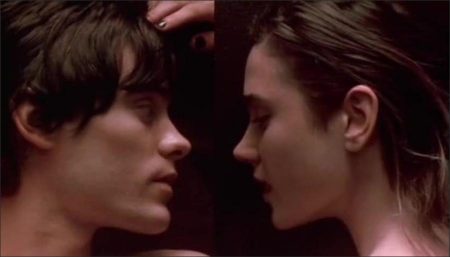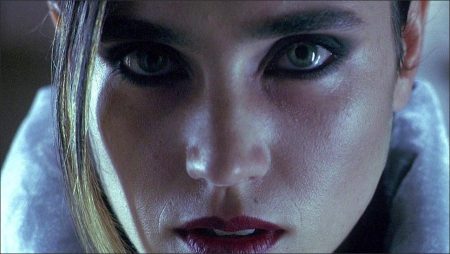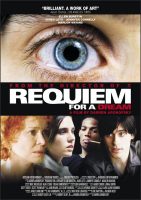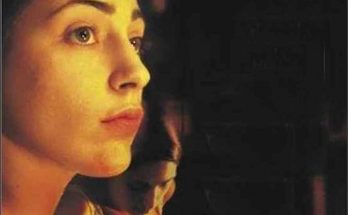Requiem for a Dream movie storyline. Sara Goldfarb (Ellen Burstyn) is a retired widow, living in a small apartment. She spends most of her time watching TV, especially a particular self-help show. She has delusions of rising above her current dull existence by being a guest on that show. Her son, Harry (Jared Leto) is a junkie but along with his friend Tyrone (Marlon Wayans) has visions of making it big by becoming a drug dealer.
Harry’s girlfriend Marion (Jennifer Connelly) could be fashion designer or artist but is swept along in Harry’s drug-centric world. Meanwhile Sara has developed an addiction of her own. She desperately wants to lose weight and so goes on a crash course involving popping pills, pills which turn out to be very addictive and harmful to her mental state.
Requiem for a Dream is a 2000 American psychological drama film directed by Darren Aronofsky and starring Ellen Burstyn, Jared Leto, Jennifer Connelly, and Marlon Wayans. The film is based on the novel of the same name by Hubert Selby, Jr., with whom Aronofsky wrote the screenplay.
The film depicts four different forms of drug addiction, which lead to the characters’ imprisonment in a world of delusion and reckless desperation that is subsequently overtaken by reality, thus leaving them as hollow shells of their former selves. Requiem for a Dream was screened out of competition at the 2000 Cannes Film Festival and received positive reviews from critics upon its U.S. release. Burstyn was nominated for an Academy Award for Best Actress for her performance.
Requiem for a Dream premiered at the 2000 Cannes Film Festival on May 14, 2000 and the 2000 Toronto International Film Festival on September 13 before a wide release on October 27.
As in his previous film, π, Aronofsky uses montages of extremely short shots throughout the film (sometimes termed a hip hop montage). While an average 100-minute film has 600 to 700 cuts, Requiem features more than 2,000. Split-screen is used extensively, along with extremely tight closeups. Long tracking shots (including those shot with an apparatus strapping a camera to an actor, called the Snorricam) and time-lapse photography are also prominent stylistic devices.
To portray the shift from the objective, community-based narrative to the subjective, isolated state of the characters’ perspectives, Aronofsky alternates between extreme closeups and extreme distance from the action and intercuts reality with a character’s fantasy. Aronofsky aims to subjectivize emotion, and the effect of his stylistic choices is personalization rather than alienation. The camera serves as a vehicle for exploring the characters’ states of mind, hallucinations, visual distortions, and corrupted sense of time.
The film’s distancing itself from empathy is structurally advanced by the use of intertitles (Summer, Fall, Winter), marking the temporal progress of addiction. The average scene length shortens as the film progresses (beginning around 90 seconds to two minutes) until the movie’s climactic scenes, which are cut together very rapidly (many changes per second) and are accompanied by a score which increases in intensity accordingly. After the climax, there is a short period of serenity, during which idyllic dreams of what may have been are juxtaposed with portraits of the four shattered lives.
Requiem for a Dream (2000)
Directed by: Darren Aronofsky
Starring: Ellen Burstyn, Jared Leto, Jennifer Connelly, Marlon Wayans, Christopher McDonald, Louise Lasser, Marcia Jean Kurtz, Janet Sarno, Marcia Jean Kurtz
Screenplay by: Hubert Selby, Jr., Darren Aronofsky
Production Design by: James Chinlund
Cinematography by: Matthew Libatique
Film Editing by: Jay Rabinowitz
Costume Design by: Laura Jean Shannon
Set Decoration by: Ondine Karady
Art Direction by: Judy Rhee
Music by: Clint Mansell
MPAA Rating: R for intense depiction of drug addiction, graphic sexuality, strong language and some violence.
Distributed by: Artisan Entertainment
Release Date: October 27, 2000
Views: 147
